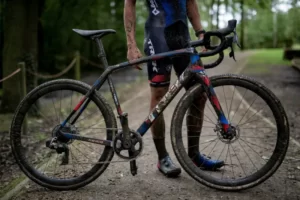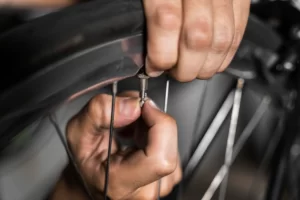Step by Step Guide: How to Replace Handlebar Grips and Tapes on Your Bike
As a bicycle enthusiast, one of the most important parts of your bike is the handlebar. The handlebar is the part of the bike that is responsible for steering and controlling the bike’s direction. However, if the handlebar grips are worn out or damaged, it can be quite challenging to handle the bike. So, if you need to replace your bike’s handlebar grips and tapes , this step-by-step guide will help.
Tools you’ll Need
– New bike grips
– Handlebar end caps or plugs
– Allen wrenches
– Razor blade or sharp knife
– Clean rag
– Rubbing alcohol
– Adhesive
Step 1: Remove the Old Grips
To replace the old handlebar grips, you have to remove them first. This step can be challenging if the handlebar ends have been plugged or taped, but it is necessary to have the old grips removed to fit new ones. Use a razor blade or a sharp knife to carefully cut the old grips and remove them from the handlebar. You may need to use a flathead screwdriver or Allen wrench to loosen any bolts or screws that are holding them in place. Once you’ve done that, you can simply slide the grips off the handlebars. If you cannot remove them manually, you can cut them off with a pair of pliers.
When removing the old grips, if they are difficult to slide off, you can use a small amount of soapy water or lubricant to help loosen them up.
Step 2: Clean the Handlebar Surface
Before fitting the new grips, remove old grips and residue by using a clean rag to remove any old grips or residue from the handlebar surface. If there is any sticky residue left behind, apply a small amount of rubbing alcohol or isopropyl alcohol to a clean rag. Make sure to use enough alcohol to thoroughly clean the handlebar surface, then use the rag to clean the handlebar surface thoroughly, making sure to remove any dirt,
oil, or other debris. This will help to guarantee that the new grips are well attached.
This will help to remove any dirt or residue that may have built up over time, leaving the surface clean and smooth.
Then let the handlebar surface dry. Once you’ve cleaned the handlebar surface, let it dry completely before installing the new grips. This makes sure that the fresh grips attach properly and stay on.
Step 3: Install the New Bar End Grips
Before you install the new grips, make sure that they are the correct size for your handlebars. Slide the grip onto the handlebar after applying a small amount of alcohol to the inside of the grip. You may need to apply some pressure for the grip to fully engage.
If you are using bar-end grips, insert them into the handlebar by loosening the bolt on the side of the handlebar. Slip the grip onto the handlebar end, tighten the bolt, and ensure the grip is secure.
If your new grips don’t have any screws or bolts, you can use a small amount of adhesive or grip glue to hold them in place. Follow the manufacturer’s directions for applying the adhesive or grip glue.
If you are having trouble getting the new grips to slide on, you can use a hair dryer or heat gun to warm up the grip slightly. This will soften it and make it easier to slip onto the handlebar.
Step 4: Install the New Handlebar Grips
Depending on the type of bike grips you are using, there are many different types of handlebars grips available, so make sure to choose ones that are comfortable for you and suit your riding style. then slip them onto the handlebar by aligning the pre-made holes with the handlebar ends. Gently twist them into place and ensure they fit correctly.
If your handlebars have any electrical components or wiring, make sure to be careful when removing and installing the grips so as not to damage them.
Step 5: Secure the Grips with Adhesive
Some bike grips come with adhesive that you smear into the grip so they don’t slide around. If your bike grips do not come with adhesive, you can apply some grip glue (e.g., hair conditioner, dish soap) in between the grip and the handlebar.
Once the new grip is in place, use the screws or bolts that you removed earlier to secure it in place. Make sure that the grip is aligned properly before you tighten it down.
Step 6: Cover the Handlebar End with End Caps/Plugs
You do not want any dirt or debris getting into your bike handlebars, so ensure that you cap them off with either end caps or plugs. These act as a protective barrier for the handlebar’s internal structure.
Replacing Handlebar grips is an easy process that does not take much time. You only need a few basic tools and a step-by-step guide to help keep your bike in top condition. With the right tools and a bit of patience, you can replace your handlebar grips in no time, giving you enhanced control and performance on your cycling journey.
After learning how to replace handlebar grips, let's now learn how to wrap handlebar tape on a bicycle.
Step 1: Gather the Necessary Tools
Make sure you have all the necessary tools, such as two rolls of new handlebar tape, a short strip of adhesive tape, two finishing tapes, two handlebar end plugs, scissors, and electrical tape.
Step 2: Remove the Old Tape
Use scissors to cut and slowly remove the old tape, being careful not to damage the fabric underneath.
Step 3: Prepare the Handlebar
Ensure the handlebar is clean and dry. You can also use adhesive tape to secure the plastic ends at the handlebar’s edges.
Step 4: Start Wrapping the New Tape
Begin wrapping the tape around the end of the handlebar. Place some adhesive tape at the beginning of the wrap to secure it.
Step 5: Wrap Upward at a 45-Degree Angle
Start wrapping the tape upward at about a 45-degree angle. Keep the wraps close to each other for a secure fit.
Step 6: Continue Wrapping
Continue wrapping the tape evenly until you reach the end of the handlebar.
Step 7: Trim Excess
Use scissors to trim any excess tape, and make sure to secure the final end well. Wrap electrical tape at the end of the tape for added stability.
Step 8: Repeat the Process
Repeat the same process for the other handlebar.
Step 9: Check for Stability
Ensure that the tape is securely wrapped and doesn’t move. Gently press on the tape to ensure its firmness.
By following these steps, you can easily wrap handlebar tape on your bicycle. Remember to be precise and maintain even tension for the best results.
In conclusion, having walked through the process of replacing handlebar grips and tapes and carefully installing new grips, it becomes clear that attending to the bike handles is not just a routine maintenance task, but it’s a fantastic way to enhance the comfort and performance of your biking adventures. To complete the improvement of your riding experience, we’ve also learned the precise technique of wrapping the handlebar tape, which promotes a secure grip and provides an enhanced feel and extra comfort during your rides.
By following these simple, effective steps, you can now enjoy biking with maximum comfort and performance. And remember, take your time while putting the new grips and tapes on. Rushing the process might lead to mistakes and cracked or insecure grips. Take your time, follow the instructions carefully, and remember to test the grips before riding your bike. And most importantly, enjoy your ride!






